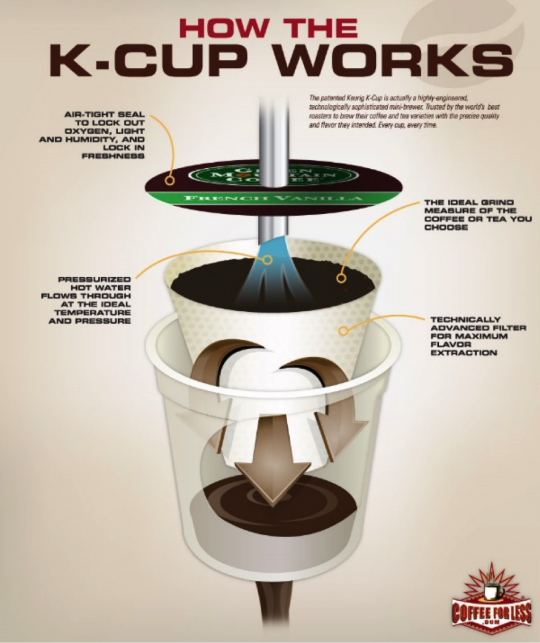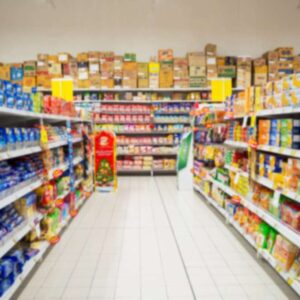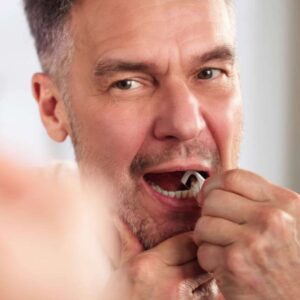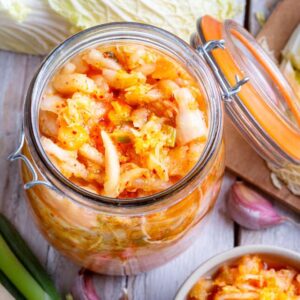
The Common Kitchen Appliance That’s Destroying Your Health
- Your #1 source of antioxidants may also be causing man-boobs
- This popular kitchen convenience doubles your dose of synthetics
- One easy way to brew your antioxidants without added hormones
Dear Reader,
For most of us, the day doesn’t start until after the first cup of coffee.
And with good reason, coffee drinkers enjoy many health benefits from their morning brew.
However, there is a major health problem lurking in the most popular types of coffee brewing systems: flame retardants and estrogenic chemicals.
This nasty brew of synthetics can lead to issues such as obesity, Type 2 diabetes, and, even worse, reproductive disorders like man-boobs.
Today, we will share with you a way to brew healthy coffee without the added harm.
But first, let’s discuss the important health benefits of your morning routine… and how it could be doing more harm than good…
The Good and Bad of Your Morning Joe
Fully 54% of Americans over the age of 18 drink coffee every day.
And not just a cup of daily coffee, but 3.1 cups of it.1
More importantly, a study shows that American’s get more antioxidants from coffee than any other source — including fruits and vegetables. Due to the antioxidants in coffee’s easy absorption by the body, both decaffeinated and regular coffee provide a powerful source for regular drinkers .2
Beyond providing these cell-protective antioxidants, a study found drinking coffee can reduce your risk of developing Type 2 diabetes by 50 percent for those who drink four or more cups a day. 3
And the good news about coffee doesn’t stop there. There is research indicating coffee to have all sorts of health benefits ranging from making you happier to preventing liver cirrhosis.4
With all of these amazing health properties, plus the added caffeine boost, it seems that coffee is a no-brainer for those of us needing a little help in the mornings.
But there is some bad news — the toxins found in your coffee maker might overshadow all of the healthy benefits of your coffee.
Most automatic coffee makers have plastic brewing components. Since these plastic parts contain health-hazardous chemicals, they might be turning your daily joe from a healthful brew into a toxic swill.
However, there are healthy and plastic-free ways to get your coffee in and keep the toxins out. I will share a few helpful tips in a bit.
First, let’s get to the bottom of your coffee maker.
One Toxin With Your Coffee or Two?
If you have ever bought a new coffee maker, then you will likely remember those nasty first five–10 pots of coffee. You know, the ones that taste like Saran Wrap with a mild hint of coffee.
While the subsequent pots taste more like coffee and less like what your lunch is wrapped in, the plastic taste never totally goes away.
Regardless of its potent synthetic taste, the automatic coffee maker remains the cornerstone of many kitchens, offices, and break rooms.
In fact, I have already seen seven in the course of my day.
While these common little machines make our lives easier, they may also be slowly poisoning us with neurotoxic substances and estrogen-like chemicals.
Many plastic-based coffee makers contain endocrine-disrupting chemicals (EDCs) such as polybrominated diphenyl ethers (PBDEs), a flame-retardant substance used in molded plastics, and Bisphenol A (BPA), a common plastic additive.
These flame-retardant substances in plastics can store in human fat cells and has been detected in human blood, tissues, and breast milk. They can also cause neurological, reproductive, and thyroid issues in animals.5
For many years, BPA a plastic additive, has been known to affect fetuses and reproductive organs in humans and animals. More recently, a study has found that the endocrine-disrupting powers of BPA may lead to Type 2 diabetes.
Both of these synthetics are dangerous to humans because they interfere with the body’s natural hormone functions and can cause serious health issues.
Sometimes referred to as “gender-bending chemicals,” they lower the male hormone testosterone and boost the female hormone estrogen. For men, this means reduced virility and feminization of features, such as an increased growth of breast tissue, aka “man-boobs.” For women, this means riskier pregnancies and possible long-term issues with reproductive organs.
Andrea C. Gore, chair of the Endocrine Society task force and a pharmacologist at the University of Texas at Austin, reports:
The evidence is more definitive than ever before — EDCs disrupt hormones in a manner that harms human health. Hundreds of studies are pointing to the same conclusion, whether they are long-term epidemiological studies in human, basic research in animals and cells, or research into groups of people with known occupational exposure to specific chemicals.6
The jury is still out (for the moment, anyways) on whether PBDEs and BPA are carcinogens, but it would makes sense that if they are able to interrupt important bodily functions, they can probably cause cancer.
Beyond the nasty taste, there’s real danger in heating up those plastic parts. Boiling water speeds up the leaching process for many harmful plastic additives, including BPA.
In fact, BPA leaches out 55 times faster when exposed to hot liquids than in normal circumstances, meaning you are getting 55 times more of it with every sip of a hot beverage verses a room-temperature one.7
And to make things worse, the wildly popular single-serving coffee pod machines (like Keurig’s) may be the worst of the lot when it comes to leaching. Made almost entirely of plastic, the water reservoir provides the perfect space for chemicals to leach into the brewing water.
Hands down, the worst part of these machines are the pods (K-cups) themselves.
You know, these guys:

Photo credit: Dailytech.com
The above graphic is supposed to show you all of the benefits of the K-cup system. In reality, it shows you how hot water is plunging through yet another layer of plastic before it makes it to your cup.
And it’s the worst kind of plastic: No. 7.
No. 7 is a blend of plastics and considered to be in the “other” category of plastic types and is not recyclable.
While Keurig says these No. 7 pods are BPA-safe, the real trouble is there is new evidence that even BPA-free plastics can have estrogenic effects.
These machines are double trouble on your health. Not only are you getting a dose of toxins from the machine, but you’re now getting a bonus exposure from the hot water shooting through the pods.
So when you add all of these factors together, it looks your plastic-based automatic coffee maker is delivering you a morning cup of foul-tasting, health-ruining toxins.
And the worst part is these chemicals may be diluting coffee’s natural health benefits!
But it doesn’t have to be this way. There are several ways to make your morning brew and skip the synthetics.
Today, I will share with you a variety of plastic-free coffee makers, as well as my preferred brewing method.
Let’s dive in!
Choose a Healthy Brew
Many producers of kitchen products are now advertising as BPA-free. While buying a new BPA-free plastic automatic coffee maker may seem to be the easiest solution, it is not the safest.
Chances are even the BPA-free containers will still contain flame-retardants or other synthetics.
Your best bets are nonplastic coffee makers like French presses, percolators, and pour-overs.
French presses and percolators are some of the most flavorful ways to brew coffee without plastic parts. These methods don’t use filters, so your brew contains all of the coffee’s natural oils, enhancing the flavor.
However, studies have shown this may not be the most optimal method if you have high cholesterol. Coffee oils contain cafestol. Cafestol can increase overall levels of cholesterol, LDL cholesterol, and triglycerides.10 Most experts agree the occasional French press cup of coffee is perfectly safe, but you may not want to make it your daily coffee.
Your best option is to use a pour-over coffee system, as it uses a filter and is typically made of porcelain or glass.
The Hario V60 is an easy-to-use pour-over and is available without plastic components.
Click here for more information on the V60 and here for filters.
No matter your method, it’s important to use organic coffee and an unbleached paper filter every time you brew to reduce chemical exposures.
If you have a plastic-free coffee method you want to share, please do! nmoore@lfb.org
Live well,

Natalie Moore
Managing editor, Living Well Daily
P.S. Ordering drip coffee from a cafe isn’t necessarily a healthier option. As a former barista, I can attest that several commercial brewers have plastic parts. Not to mention the added exposure from plastic-lined cups and plastic lids, stirrers, and straws. However, many cafes offer pour-over or French press options.
Sources
[2] Coffee is number one source of antioxidants
[3] Why coffee drinking reduces the risk of Type 2 diabetes
[4] 11 Reasons You Should Drink Coffee Every Day
[5] Technical Fact Sheet – Polybrominated Diphenyl Ethers (PBDEs) and Polybrominated Biphenyls (PBBs)
[6] BPA exposure has been linked to an increase in diabetes and obesity
[7] Plastic (Not) Fantastic: Food Containers Leach a Potentially Harmful Chemical
[8] Your Coffee Pods’ Dirty Secret
[9] Styrene
[10] Does Coffee Raise Cholesterol?
Written By Natalie Moore
Natalie Moore is a dedicated health researcher with a passion for finding healthy, natural, and science-based solutions. After a decade of direct healthcare experience in western and natural medicine, she was involved in public health research before joining Living Well Daily.
View More Free Articles
Stop Obsessing Over Diet Trends
Can we stop with the endless diet debates already? Every other week there’s a new headline shouting about which diet is best for weight loss, heart health, or diabetes. Paleo, keto, low-carb, high-protein… it’s exhausting. And now, a new meta-analysis is out comparing the Mediterranean diet, the DASH diet, and something called AHEI (that’s “Alternative...
A New Reason to Ditch Processed Junk
If you’ve ever walked the inside aisles of your local grocery store and thought, “This is all just junk,” your instincts were spot on. A new study published in the journal Thorax just added another red flag to the list of dangers linked to ultra-processed food—a 41 percent higher risk of lung cancer. That’s right....
When Being Winded on Stairs Is Serious (And When It Isn’t)
I had an athlete visit me recently because he experienced shortness of breath while climbing stairs. He is in great shape, so he was worried about what it might mean. “Doc,” he said, “I run five miles three times a week. Why am I huffing and puffing after two flights of stairs?” His concern is...
Study EXPOSES Hidden Danger Lurking in Your Car
We think of our homes and cars as safe havens. But according to a startling new study, they may be flooding your lungs with microscopic plastic particles—every single day. Researchers in France recently found that adults inhale an average of 68,000 microplastic particles daily from indoor air alone. To put that in perspective, that’s about...
Mailbag: Is Modern Food Making You Snore?
“What can cause snoring, and is there a way to correct this issue?” —Seeking Silence Hi Seeking, Snoring happens when the soft tissues in your throat relax and vibrate as air passes through during sleep. While several factors can cause snoring—from sleep position to nasal congestion—I want to share one trigger that might surprise you....
Simple Food Swap SLASHES Dementia Risk 28%
Let’s be honest… who would jump at the chance to cut their dementia risk by 28 percent. And no, you don’t need to run marathons, survive on broccoli, or learn to play the zither (whatever that is) to make it happen. All it takes is one easy swap—something that’s probably already in your refrigerator. Researchers...
This SMART Floss Exposes Hidden Health Danger
Scientists have created dental floss that doesn’t just clean between your teeth—it also tracks your stress while you’re flossing. Now, I know what you’re thinking… “Great—now even flossing is going to stress me out by telling me how stressed I am.” But this fascinating new tool from Tufts University could be a game-changer for understanding...
Is This "Safe" Sweetener Damaging Your Brain?
The headlines are alarming… “Popular Sugar Substitute Linked to Brain Cell Damage” and “Erythritol Could Damage Critical Brain Barrier” are just two of the dozens I’ve spotted recently. But before you toss every sugar-free product in your pantry, let’s take a closer look at what this study actually shows—and what it doesn’t. The latest research...
This Summer Threat Could SPIKE Your Blood Sugar
Picture this… It’s another scorching hot summer day. You crank up the air conditioning while watching the weather forecast, which predicts yet another “record-breaking” heat wave. It’s starting to feel like just another miserably uncomfortable summer. But what you might not realize is that—if you have diabetes—those rising temps could do far more damage to...
Move Over Yogurt—5 Foods That Pack MORE Probiotics
Let’s talk about your gut. The microbiome is the collection of trillions of bacteria and other tiny organisms that live in and on your body—especially in your gut—and help keep you healthy. I’ve written often about how vital it is to maintain a healthy microbiome. And you might have dutifully added yogurt to your shopping...









